|
|
|
Sort Order |
|
|
|
Items / Page
|
|
|
|
|
|
|
| Srl | Item |
| 1 |
ID:
154523
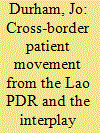

|
|
|
|
|
| Summary/Abstract |
Healthcare is most often examined within the confines of nation-states. Such an analysis, however, is not necessarily indicative of reality, with people often travelling across borders for healthcare. This paper explores cross-border travel for medical care by patients in the Lao People's Democratic Republic. The paper shows that while travelling across borders for medical care is not new, how, why and who travels across borders have changed in tandem with changes in the political and socio-economic landscape. The paper is based on a review of the literature and qualitative interviews with patients who had crossed the border for planned healthcare (N = 43), Laotian medical officials working in public institutions (N = 5) and international health advisors (N = 6). Patients came from different districts, a range of socio-economic backgrounds, had crossed borders for planned healthcare in the last two years and, based on key informant subjective assessments, were information-rich respondents. The study reveals how Lao cross-border patients creatively use the cultural and social resources at their disposal to obtain the healthcare they desire. In particular, it draws attention to the interplay between social, economic and cultural capital, and habitus in navigating access to transnational healthcare.
|
|
|
|
|
|
|
|
|
|
|
|
|
|
|
|
| 2 |
ID:
164422
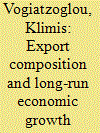

|
|
|
|
|
| Summary/Abstract |
Export expansion can be a significant engine of economic growth for developing economies. The size of the growth effect of exports depends not only on volume but also on the sectoral composition of exports. By explicitly considering the sectoral export composition, this article examines over a 31-year period the long-run growth impact of exports in four transition and emerging economies of the Association of Southeast Asian Nations (ASEAN), namely Cambodia, Laos, Myanmar and Vietnam. More specifically, for each country, a long-run equilibrium analysis within a cointegration framework is conducted for three broad sectors (agriculture, mining/natural resources and manufacturing) as well as for 22 manufacturing industries during 1987–2017. The results indicate that there has been sizeable export expansion (especially in Vietnam), but export composition differs substantially across economies, which has an effect on the overall growth impact of the country’s exports. Clear evidence of export-led growth is found only for some sectors. Countries that rely heavily on primary goods have experienced relatively lower export-led growth. Export restructuring in manufacturing industries is associated with a larger long-run growth effect for a country’s exports. Our findings suggest that policies encouraging diversification away from traditional export sectors would be expected to lead to higher long-run growth effects of exports. Furthermore, our analysis implies a steady strengthening of export dynamism in ASEAN ‘latecomer’ economies and their rising significance in the global trade system.
|
|
|
|
|
|
|
|
|
|
|
|
|
|
|
|
| 3 |
ID:
103953
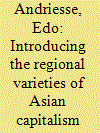

|
|
|
| 4 |
ID:
174813


|
|
|
|
|
| Summary/Abstract |
Increasing demands for energy to boost the Mekong economies have attracted the keen interest of riparian countries for hydropower development. This is evidenced by extensive investment in hydropower projects across the region over the last few decades. Drawing on interviews with key stakeholders, including officials from Ministry of Energy and Mines, Ministry of Natural Resources and Environment, Ministry of Agriculture and Forestry, private sector actors, civil society organisations and academics, as well as secondary data from public and policy resources, this paper aims to examine how the government of Laos' (GoL) decisions in hydropower development are influenced by regional energy dynamics, and how these shape the country's future energy development. The paper argues that the GoL's decisions on hydropower development are highly dilemmatic, given the current limited institutional capacity in hydropower governance and the accelerating evolution of alternative energy in neighbouring countries. While uncertainty in power markets is recognised, this places greater pressure on new hydropower projects as to how much power could be sufficiently produced and exported. The paper calls for GoL's policy considerations on the development and planning of alternative energy to secure the sustainable and equitable use of water resources as stipulated in the 1995 Mekong Agreement.
|
|
|
|
|
|
|
|
|
|
|
|
|
|
|
|
| 5 |
ID:
093476
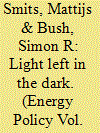

|
|
|
|
|
| Publication |
2010.
|
| Summary/Abstract |
The article describes the widespread use of an estimated 60,000 low-head pico-hydropower turbines and well-developed networks of supply and support in the Northern part of the Lao People's Democratic Republic (Lao PDR). This apparent widespread use is contrasted with the policy narratives of key actors in the government, multilateral organisations and the private sector which show an often simplified and overly negative attitude towards pico-hydropower. Based on empirical research carried out in three upland districts and the capital, Vientiane, the paper critically investigates the apparent disjuncture between policy and practice by placing pico-hydropower within the broader political context of rural electrification in the Lao PDR. It is argued that the neglect of pico-hydropower and other off-grid household electrification technologies is a result of an endemic lack of information on which to base policy decisions, the orientation of the government to facilitate large scale foreign investment in large hydropower dams, the universal applicability of solar home systems, and the broader state agenda of centralisation and control over service provision to remote upland areas.
|
|
|
|
|
|
|
|
|
|
|
|
|
|
|
|
| 6 |
ID:
111142
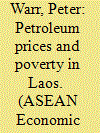

|
|
|
| 7 |
ID:
187013


|
|
|
|
|
| Summary/Abstract |
The Kuang Si Waterfall in Luang Prabang, Lao PDR, is an iconic tourist destination and supplies critical irrigation water to several downstream villages. The upstream catchment area, or the Kuang Si watershed area, comprises several villages belonging to three separate districts. The aim of this study is to understand how the watershed area of the Kuang Si Waterfall has been managed to ensure a steady, reliable flow of water resources for downstream agricultural and recreational use, in a context whereby slash-and-burn is commonly practised by upland farmers. The governance of the watershed has evolved from a top-down approach in the 1980s to one that embodies integrated watershed management in the recent decades: community-based forest and land allocation along with livelihood improvement projects. However, the focus on watershed health could be diluted through the latter approach. Drawing on ideas in the commoning literature, I show that there are ongoing forms of ‘lite commoning’ that enable upstream communities to see a stake in protecting the downstream water resource. Transitioning from ‘lite commoning’ to ‘strong commoning’ could help wean watershed programmes off development aid and make them more self-sustainable, but I argue that it is foremost important to determine the hydrological watershed boundaries.
|
|
|
|
|
|
|
|
|
|
|
|
|
|
|
|
| 8 |
ID:
111472
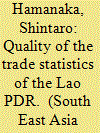

|
|
|
|
|
| Publication |
2011.
|
| Summary/Abstract |
This paper assesses the quality of the trade statistics of the Lao People's Democratic Republic (Lao PDR) by comparing its export/import data with the import/export data of its trading partners (mirror data). The author finds, first, that publicly available Lao PDR statistics compiled by the Ministry of Industry and Commerce (MIC) are not consistent with the Harmonized System (HS) of classification. It would therefore be advisable for the Lao PDR to release the HS classification-based data. Second, there is concern about the quality of the import data. For example, total imports from major trading partners are less than half of the total of those partners' recorded exports to the Lao PDR. Lao PDR imports of fuel and gas, vehicles and parts, plus construction materials, do not seem to be correctly reflected in the statistics. The government's policy of controlling domestic prices, irrespective of international prices, seems to produce incentives for import smuggling. Third, the overall quality of the Lao PDR's export data is good compared with its import data. Most of the differences between the respective statistics of the Lao PDR and its trading partners are connected with mineral-related and wood-related products. However, export restrictions on raw logs, for example, which aim to support domestic wood processing industries, seem to produce incentives for export smuggling. The unsatisfactory quality of the trade statistics, especially with regard to imports, has important policy implications. First, there is a large loss in tariff revenue. Second, while annual Lao PDR trade deficits appear to be small or moderate if calculated using MIC statistics, the actual deficits are likely to be far larger.
|
|
|
|
|
|
|
|
|
|
|
|
|
|
|
|
| 9 |
ID:
147458


|
|
|
|
|
| Summary/Abstract |
One of the unexpected outcomes of increased regional integration in southern Laos has been a boom in household production and roadside sale of wood charcoal. This paper develops an ethnographically informed analysis of charcoal as a socially embedded market, providing insights into the sociopolitical relations of access, legal and extra-legal regulations, and the distribution of rents that characterise this trade. Contrary to some assumptions about charcoal as a necessarily exploitative commodity, this paper points to some of the advantageous income smoothing opportunities that charcoal presents for many rural Lao households and detail the complex ways in which charcoal production can relate to forest sustainability and degradation. The paper elaborates a perspective of entrepreneurial Lao charcoal communities, energetically utilising locally available natural resources, for direct cash income. Charcoal production networks also connect everyday household livelihoods in Laos to large-scale extractive industry, in ways that have been arguably underemphasised previously. At the same time, the charcoal trade highlights the structural limits to notions of smallholder agency and local participation in commodified market relations, within broader political-economic contexts decidedly shaped through uneven development, and accumulation through dispossession.
|
|
|
|
|
|
|
|
|
|
|
|
|
|
|
|
|
|
|
|
|